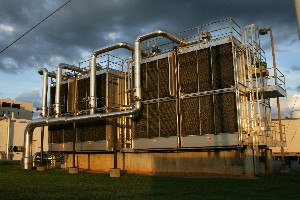A computer engineer at University of California in San Diego (UCSD) looked no further than his own office building to conduct research on the use of sensors and computer algorithms to better control heating, ventilation, and air conditioning (HVAC) systems. Yuvraj Agarwal and his colleagues at UCSD presented their findings yesterday at an Information Processing in Sensor Networks conference in Chicago.
According to the U.S. Department of Energy, commercial buildings offer ripe opportunities for energy savings. In 2006, the U.S. had nearly 75 billion square feet of commercial floor space. That year, commercial buildings consumed 18 percent of the country’s primary energy and 36 percent of its electrical power.
In UCSD’s computer science and engineering building, where Agarwal works, HVAC systems account for between 25 and 40 percent of total annual electricity load. Like many office buildings, its energy management systems use one static schedule for the building as a whole to turn on and off the HVAC systems, generally coinciding with weekday working hours.
While this one-size-fits-all approach may seem overly simple and wasteful, it’s realistically the only control the building managers can exercise, given that they have no way of knowing which areas of the building are occupied at any given time. Agarwal’s team developed a solution to give building managers a better set of tools, namely a network of sensors to keep track in real time of which areas of the building are occupied.
The UCSD researchers deployed the occupancy sensor network across an entire floor of the CSE building. The technology combines a passive-infrared (PIR) movement sensor — like those used to sense occupancy to turn on and off room lights — magnetic reed switch. The switch involves a small magnet fitted on the door so that when the door is closed, the magnet and reed switch become adjacent, thus detecting when a door is open or closed. Tests of the combined occupancy sensor show it’s accurate 96 percent of the time, with minimal false positives — not mistakenly detecting someone’s presence in an office when there is no one there.
To go along with the sensors, the UCSD researchers designed a control architecture for individual HVAC zones on the floor based on occupancy information. The sensors connect to a wireless module and base station, which send the information to a database and computer server that analyzes the sensor data. The researchers, with the consent of building managers, used the real-time data from each sensor node to turn the floor’s HVAC systems on or off.
The sensors detected several periods of low occupancy when HVAC systems were fully operating, and thus wasting energy. This active rather than passive management of HVAC systems, says Agarwal, saved between 9.5 and 15.7 percent of the building’s energy while still meeting the building’s performance requirements.
Their system, however, encountered another and significant barrier — the cost of sensors and their deployment. They found the least expensive commercial sensor to cost about $100.00 each. The team decided to build the sensors themselves, at about one-tenth of that cost, making the system cost-effective, at least in that building.
Read more: ‘Green’ Treatments Fail to Stop Bacteria in Commercial A/C
* * *


 RSS - Posts
RSS - Posts
[…] Read more: Sensors, Computer Controls Reduce Building HVAC Energy […]